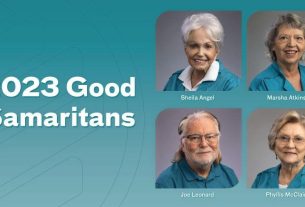[ad_1]
GREENFIELD — Of the drug residue samples Tapestry Health has sent to Brandeis University for testing, roughly half are coming back positive for the animal tranquilizer xylazine, a development that is affecting responses to overdoses.
“When responding to an overdose now, it’s not necessarily assumed that it’s going to be an opiate, so Narcan may not always work,” explained Amy Davis, assistant director of rural harm reduction operations at Tapestry Health, which provides health care and support services in the four counties of western Massachusetts. “We should still give Narcan, but we need to focus on breathing.”
Xylazine — a sedative used in veterinary medicine — is not necessarily a new adulterant, Davis said, noting reports of it being used in Puerto Rico and Philadelphia. In recent months, however, the region has “really seen an uptick” in its presence in the drug supply.
The challenge with xylazine, Davis said, is that while it produces similar sedative effects to opioids, it isn’t an opioid.
“That makes it difficult to reverse an overdose,” Davis said. “A lot of time, people are looking for that quick wake-up, and that’s not necessarily what’s going to happen.”
Xylazine can cause unresponsiveness or decreased consciousness, low blood sugar, low blood pressure, slowed heart rate and reduced breathing, according to Massachusetts Drug Supply Data Stream (MADDS), the state-funded collaboration among Brandeis University researchers, the Massachusetts Department of Public Health and various municipal police departments.
In light of this, Davis and other harm reduction advocates are emphasizing the importance of giving rescue breaths after administering the overdose-reversing medication Narcan, also known as naloxone. They also advise calling 911.
“We’ve been doing more wound care in the community and making sure people have fresh syringes for injection … and supplies for wound care,” Davis said, explaining that xylazine also puts people at higher risk for abscesses and other skin wounds.
According to MADDS, 28% of samples sold as fentanyl and heroin between January and June 15 in Massachusetts were positive for xylazine. That’s compared to 31% of samples in 2021 and 13% in 2020.
The MADDS study has also found that between January and June 15, xylazine was more often present in drugs that were sold as heroin or fentanyl in parts of western Massachusetts than in the eastern part of the state.
According to the study, which was published in July, samples for testing were provided by harm reduction programs, such as Tapestry Health, and police departments. Davis said Tapestry sends “drug trash,” or anything with visible residues, such as bags, cookers or cottons used for injection.
“I don’t really know why it’s showing up,” Davis said, though they speculated “this is the next wave” in adulterants used to “cut” heroin, fentanyl or other drugs. “It’s not just in the dope supply — we’re finding it in cocaine.”
Northampton Police Chief Jody Kasper wrote in an email that the department and its officers are aware of xylazine’s presence in the region. “We keep updated with current trends in illegal substances so that we can best respond to medicals and for our own safety in case of exposure,” Kasper wrote.
And while overdoses are also increasing — in Greenfield, opioid-related overdoses doubled between 2020 and 2021, according to the Department of Public Health — Davis noted the study doesn’t necessarily link that to xylazine.
Greenfield Acting Police Chief William Gordon said although his officers haven’t come across evidence of it in Greenfield, they are familiar with the substance and are trained in responding to suspected overdoses where xylazine may be present.
In hospitals, Dr. William Soares III, who specializes in emergency medicine at Baystate Health, said the emergency rooms at Baystate Franklin Medical Center in Greenfield and Baystate Medical Center in Springfield are seeing more “atypical presentation” of patients suspected to have overdosed.
“They’re sedated for a longer amount of time, or when they have Narcan, they don’t completely wake up,” he explained.
Soares said the hospitals don’t have the capability to test for xylazine, as it’s not included as part of standard urine or drug screens.
“That’s true on the patient level. … Xylazine is a white powder,” he said. “There’s no way for someone who uses drugs to tell by looking at it that it could potentially be cut with xylazine.”
Like others, Soares emphasized the importance of administering Narcan in suspected opioid overdoses. He said the medication can be purchased without a prescription from any pharmacy.
“Although naloxone does not reverse the xylazine, it will reverse (the effects of) fentanyl or opioids,” he said. “That may be the thing that is enough to restore breathing and help keep them alive, and that is even more important now.”
Reporter Mary Byrne can be reached at mbyrne@recorder.com or 413-930-4429. Twitter: @MaryEByrne.
[ad_2]
Source link



